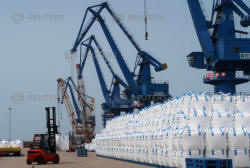Hengli's high-tech petroleum complex breathes down
PetroChina's neck
 Send a link to a friend
Send a link to a friend
 [September 10, 2018]
By Chen Aizhu and Meng Meng [September 10, 2018]
By Chen Aizhu and Meng Meng
DALIAN, China (Reuters) - On reclaimed land
on the island of Changxin near the port of Dalian, workers are putting
the finishing touches on a plant that is the future of China's refining
and petrochemical industry.
Here, private chemical company Hengli Group will begin testing its $11
billion oil refinery and petrochemical complex in October.
The plant is a direct challenge to China National Petroleum Corp's (CNPC)
Dalian Petrochemical Corp facility, the country's second-largest oil
refinery. That 70-year-old plant has been a cash cow for state-owned
CNPC but the aging refinery has come under scrutiny after several
accidents.
Hengli's <600346.SS> high-tech complex will not only produce the fuels
China craves but also the plastics and other chemicals the country will
need for the future.
China plans to add a dozen petrochemical mega-complexes along its east
coast over the next five years, in the biggest wave of expansion in its
history.

The plants will be backed by state majors Sinopec and Sinochem, private
groups Shenghong Petrochemical and Wanhua Chemical, as well as Exxon
Mobil and Germany's BASF.
"Under a more liberalized policy, more independent and foreign companies
will join the investment that will make China more self-sufficient in
chemicals," said William Chen, chemicals analyst at IHS Markit.
CNPC's listed arm PetroChina Co <601857.SS>, which operates Dalian, has
become one of the world's most valuable oil firms by providing the
gasoline and diesel to power China's expanding private car fleet and the
freight trucks underpinning its expanding commerce.
But Dalian may become a symbol of the past as competitors such as Hengli
feed the demand of the world's biggest petrochemical consumer.
China's demand for diesel will likely peak by 2020 and gasoline by
around 2035, according to IHS Markit.
However, the country's demand for ethylene, a building block for
plastics and polyesters, will rise to 26.8 million tonnes by 2020, from
18.7 million tonnes in 2015, according to consultancy Globaldata.
Hengli's sprawling complex is geared to meet that demand and reduce
imports.
It will be followed by a similar one in Zhejiang province by private
polyester company Zhejiang Rongsheng Holding Group.
The sites for these mega projects include Zhanjiang and Huizhou in south
China's Guangdong province, Zhangzhou and Quanzhou in east China's
Fujian province, and Lianyungang in Jiangsu, with plants to be situated
on islands or peninsulas far away from residents to contain
environmental risks.
Meantime, China may raise its oil refining capacity by about 16 percent
to 20 million barrels per day (bpd) by around 2023, according to a
Reuters tally of announced projects. This will result in a surplus of
about 3 million bpd, equal to about one-fifth of Europe's refining
capacity, as fuel demand growth stagnates.
While China's government has not stated a specific target for closing
down the excess capacity, industry executives have raised concerns about
the widening glut.

Ethylene capacity will rise by 14 million tonnes a year during the same
period, up by 76 percent from the current total estimated production,
according to a count of announced projects.
GRAPHIC: China's petrochemical demand is rising fast - https://tmsnrt.rs/2PB6aF6
[to top of second column] |

A worker drives a forklift past sacks of polyester-making chemicals,
waiting to be shipped, at Hengli Petrochemical's new refining,
petrochemical complex at Changxing island in Dalian, Liaoning
province, China July 16, 2018. Picture taken July 16, 2018.
REUTERS/Chen Aizhu

FULL FLEXIBILITY
Hengli's new facility, showcasing private participation in the sector, will be
one of the world's biggest.
It has a quota to import 20 million tonnes of crude oil a year, about 400,000
bpd and equal to its total refining capacity, the most of any independent
refiner.
Hengli said it has signed agreements with state-owned Sinochem to import crude
and export fuels, and signed Sinopec, CNPC's biggest national rival, as a
domestic fuel marketing agent.
In addition to its crude distillation capacity, the Hengli complex will have two
3.2-million-tonnes-per-year residue hydrocracking units, and three 3.2 million-tonnes-per-year
reforming units.
For chemicals, it will have a 1.5-million-tonnes-per-year ethylene unit and two
2.25-million-tonnes-per-year paraxylene units.
"Integration gives us full flexibility to optimize output among oil, olefins and
aromatics as and when that market is in favor," said Hengli's spokesman Li Feng,
"It will be one of the industry's most profitable plants."
Beyond China, Hengli's new facility will also challenge north Asian rivals and
force them to cut output, said Steve Jenkins, a vice president at consultants
Wood Mackenzie.
GRAPHIC: Map of China's refining & petrochemical facilities - https://reut.rs/2NNrtTb
OLD NEIGHBOR
PetroChina's Dalian plant has the same crude refining capacity as the Hengli
site but its fortunes have turned since a deadly pipeline blast at the oil
receiving port in 2010 caused a large spill.

Other accidents followed, the latest a fire at the plant's gasoline unit in
August 2017, resulting in tighter regulatory scrutiny from local environmental
authorities.
Dalian is located just hundreds of meters from residential housing and there
have long been complaints about safety, foul smells and pollution.
"Being a plant manager, you live under constant stress as you risk losing your
job when next accident occurs," said a site manager at Dalian, who declined to
be named as he was not authorized to talk to press.
Adding to the safety and environment concerns, Dalian's profit margins have been
squeezed by a slowdown in fuel demand and rising competition from independent
refiners.
CNPC and PetroChina declined to comment when contacted by Reuters.
Eventually, the Dalian refinery as well as similar plants that mainly produce
fuels will become redundant.
"We're caught in a dilemma. There is little space for us to upgrade, while the
cost of relocating will be too huge to bear," said the Dalian plant manager.
GRAPHIC: Global planned and announced petrochemical capacity additions by region
-
https://reut.rs/2oIpVz6
($1 = 6.8740 Chinese yuan renminbi)
(Reporting by Chen Aizhu and Meng Meng; Editing by Henning Gloystein and
Christian Schmollinger)
[© 2018 Thomson Reuters. All rights
reserved.] Copyright 2018 Reuters. All rights reserved. This material may not be published,
broadcast, rewritten or redistributed.
Thompson Reuters is solely responsible for this content. |